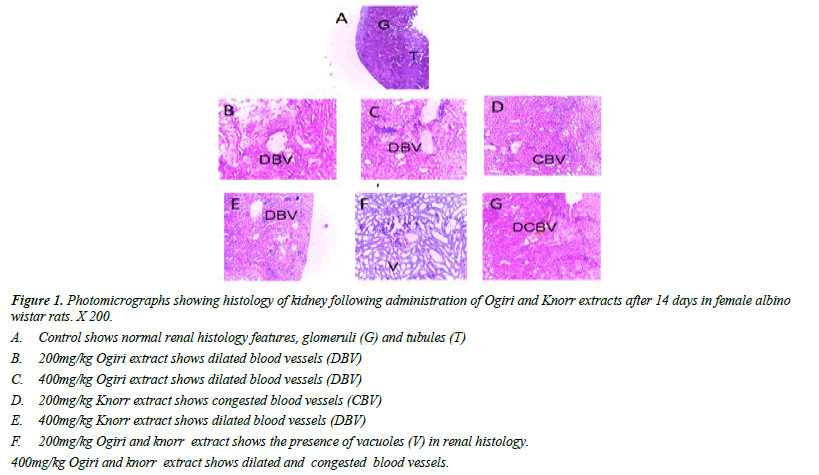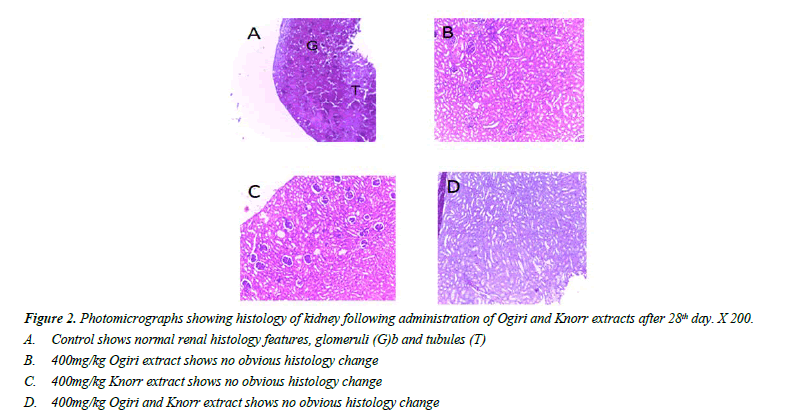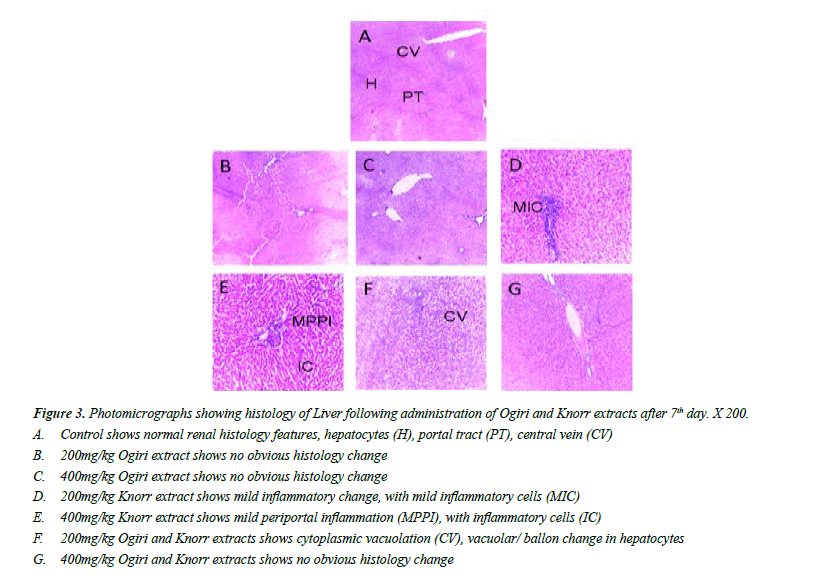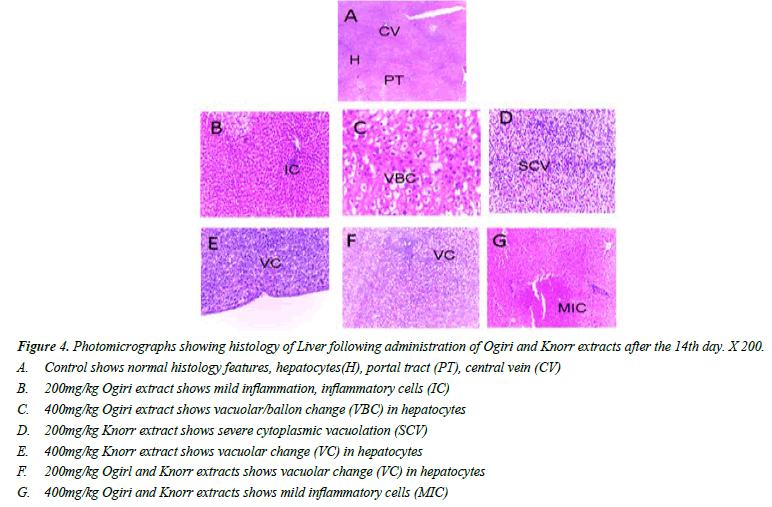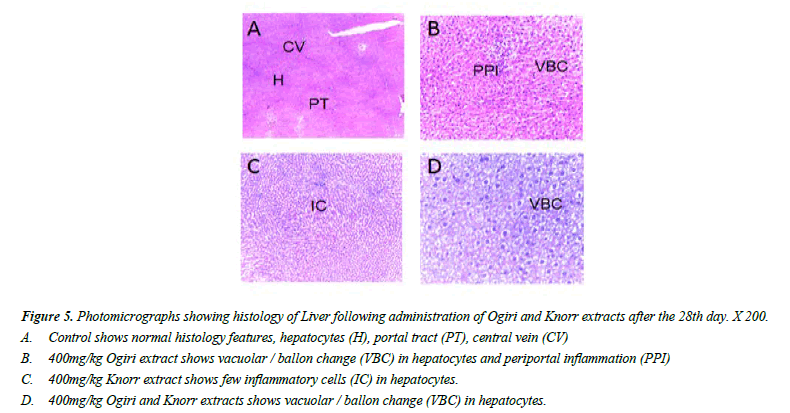Commentary - Journal of Plant Biotechnology and Microbiology (2022) Volume 5, Issue 3
Effect of fermented citrullus vulgaris (ogiri) on hepatic functions in albino wistar rats.
Chike CPR, Onyebuenyi Maureen*and Bestman Njoku
Department of Human Physiology, University of Port Harcourt, 5323 Choba Port Harcourt, Rivers State, Nigeria
- *Corresponding Author:
- Onyebuenyi Maureen
Department of Human Physiology
University of Port Harcourt, 5323 Choba Port Harcourt
Rivers State, Nigeria
E-mail: maureenhaastrup3@gmail.com
Received: 27-Apr-2022, Manuscript No. AAPBM-22-61932; Editor assigned: 29-Apr-2022, PreQC No.AAPBM-22-61932(PQ); Reviewed: 23-May-2022, QC No.AAPBM-22-61932; Published: 06-June-2022, DOI: 10.35841/aapbm-5.3.111
Citation: Maureen O, CPR Chike, Njoku Bestman. Effect of fermented citrullus vulgaris (ogiri) on hepatic functions in albino wistar rats. J Plant Bio Technol. 2022;5(3):111
Abstract
This study investigated the effects of fermented Citrullus Vulgaris (Ogiri), food condiments/ spices on hepatic functions using albino wistar rats. Ogiri was produced from Citrullus Vulgaris, a type of melon seeds following the traditional fermentation process, while online monitoring was used to evaluate microbial, hazards using standard microbiological techniques. Biochemical analysis was carried out using mindray auto – analyzer method (model: bs – 800 ms).The results by the 7th day of administration of Ogiri shows that, it increased 100 mg/kg dose-289.33U/L increased liver enzymes ALT significantly (p<0.05), while 200 mg/kg-77U/L, 400 mg/kg-78U/L doses reduced the liver enzyme when compared to the control 208.67U/L. AST was reduced at all doses of ogiri administered.100 mg/kg-1477.67U/L, 200 mg/kg-417.33, 400 mg/kg-451.33U/L. By the 14th day, administration of Ogiri decreased alanine amino transferase levels (p<0.01). Aspartate transaminase and albumin showed significant increase (p<0.05). By the 28th day, test group I-X values for aspartate transaminase decreased significantly (p<0.05) from the control group 1, increase in alkaline phosphatase levels was more significant p<0.05 in test group III (Ogiri 200 mg/kg). Knorr 100 mg/kg and the synergestic dose 400 mg/kg of extracts decreased albumin levels (p<0.05) respectively when compared to the control value of enzymes. The use of Ogiri overtime is reported to be among the predisposing factors to the impairment of liver functions in rats. From the result of this study, significant differences in the serum levels of Aspartate transaminase (AST), Alanine transaminase (ALT), alkaline phosphatase (ALP), albumin, total protein and blood urea nitrogen (BUN), creatinine, sodium bicarbonate to the control indicate that the absorbed constituents of extracts and its metabolites might have reacted and interacted with the hepatic cells and renal tissues to impair liver function.From this study, the significant difference in AST and total protein as compared to the control is an indication of hepato-cellular liver disease.
Keywords
Fermention, Ogiri, Condiment, Enzymes, Flavor
Introduction
Good nutrition is a basic human right [1]. Therefore, in order to have a healthy population that can promote development, the relationship between food, nutrition and health should be reinforced [2]. In recent times, attention has been focused on local seeds for possible development and use in the search for novel sources to complement the traditional ones [3]. In developing countries, one of the possible ways of achieving this is through the exploitation of available local resources, in order to satisfy the needs of the increasing population [4]. Condiments are prepared food compounds containing one or more spices, or spice extracts, which when added to a food, after it has been served, enhances the flavor of the food [5-7]. Condiments can be either simple (e.g. celery salt, garlic salt, onion salt) or compound (chili sauce, chutney, meat sauce, mint sauce, prepared mustard, etc.) [8] Spices are being used as diet components often to improve color, aroma-palatability and acceptability of food [9]. Most people love spices of one kind or another, from the basic salt and pepper to cayenne, crayfish, etc. [10]. Spices are among the most versatile and widely used ingredients in food processing [11,12]. As well as their traditional role in food flavoring and coloring, they are increasingly used as natural preservatives in active packaging [13]. Spices have played an important role in the history of civilization, exploration and, commerce as these had a universal acceptance as condiments and flavors in human diet as well as in treatment of ailments [14]. ‘Ogiri’ is an oily paste produced mainly from melon (Citrullus lanatus) seeds and consumed within the West African countries [15,16].
The production process is still a traditional family art and the fermentation is by chance inoculation [17]. It is a seasoning native to Nigeria, West Africa. It was said to be the ideal flavoring back in ancient times. This is in addition to others like iru, dawadawa, Okpei and others [18].
Materials and Method
Collection of Samples
Melon seeds were purchased from ‘Oil mill market, Port Harcourt, Rivers State, Nigeria. The melon seeds were washed, de-hulled and rewashed [19]. 600 g each of the melon seeds were boiled for 4 hrs, allowed to cool to about 30ºC, mashed and wrapped in banana leaves to ferment for five days [20].
Determination of Microbiological properties of the samples
Microbial isolation and identification was done using standard microbiological techniques [10]. Ten grams of each sample for microbiological evaluation was aseptically homogenized in 90 mL of 0.1% sterile peptone water, shaken thoroughly, and appropriate dilutions (up to 10) were prepared for microbiological studies [21]. Total viable counts were made on Plate Count Agar (PCA, Oxoid, Hampshire, U.K.), while mold and yeast counts were made on acidified Potato Dextrose Agar (PDA, Oxoid). PCA plates were incubated at 37º ± 2ºC for 24 h, while the plates for fungal and yeasts counts were incubated at 28º ± 2ºC for 72 h. Bacterial isolates were characterized based on cultural morphological and biochemical properties[22,23].
Composition of fermented Citrullus Vulgaris (Ogiri)
The composition of dried egusi seed without shell per 100 g is: water 5.1 g, energy 2340 kJ (557 kcal), protein 28.3 g, fat 47.4 g, carbohydrate 15.3 g, Ca 54 mg, P 755 mg, Fe 7.3 mg, thiamin 0.19 mg, riboflavin 0.15 mg, niacin 3.55 mg, folate 58 μg [24].
Enzyme assays
Liver function tests (LFTs), are groups of clinical biochemistry laboratory blood assays designed to give information about the state of a liver. The parameters measured include ALT, AST, ALP, and albumin. Some tests associated with functionality (e.g., albumin); some with cellular integrity (e.g., transaminase) and some with conditions linked to the biliary tract (gammglutamyl transferase and alkaline phosphatase). Several biochemical tests are useful in the evaluation and management of hepatic dysfunction. These tests can be used to (1) detect the presence of liver disease, (2) distinguish among different types of liver damage, (3) determine the extent of damage, and (4) follow the response to treatment. Albumin is a protein made specifically by the liver. It is the main constituent of total protein (the remaining from globulins). Reference range is 3.5 to 5.3 g/dl. Albumin levels are decreased in chronic liver disease, such as cirrhosis. It is also decreased in nephritic syndrome, where it is lost through the urine. The consequence of low albumin can be edema since the intra-vascular oncotic pressure is higher than the extra vascular space.
Statistical analysis
Data were expressed as mean ± SEM. The data were analyzed using one way analysis of variance (ANOVA) and Dunnett’s post hoc (multiple comparisons) test was used to determine the level significance between control and experimental group. Also comparison between test and control groups using student’s t-test was employed. All statistical analysis was done using statistical software for social sciences (SPSS) version 20.0 software. The difference was considered significant at (P>0.05).
Results
The experimental results are shown in below (Tables 1-3). From this study, the significant difference in AST and total protein as compared to the control is an indication of hepatocellular liver disease. The level of serum ALT activity has been reported to be increased as a result of gender-specific thresholds one such study conducted in the U.S identified an ALT upper limit of 29IU/L for men and 22IU/L for women. The liver is an organ which performs maximum metabolic reactions. It plays an important role in energy metabolism in the body by providing enough fuel to the brain, muscle and other peripheral organs in the body. Thus damage or distortion of the integrity of the liver could results in liver impairment or hepatic toxicity. (Figures 1-5)
| Parameters | ||||||
|---|---|---|---|---|---|---|
| Groups | Treatment | ALT (U/L) | AST (U/L) | ALP (U/L) | Total Protein (g/L) |
Albumin (g/L) |
| GROUP I | Control | 208.67 ± 2.40 | 173.30 ± 150.71 | 274.00 ± 11.79 | 60.33 ± 1.45 | 33.67 ± 2.33 |
| GROUP II | Ogiri 100 mg/kg | 780.00 ± 0.58* | 45100.33 ± 12.77* | 181.00 ± 9.07* | 64.67 ± 1.33 | 33.00 ± 1.16 |
| GROUP III | Ogiri 200 mg/kg | 770.00 ± 0.58* | 417.33 ± 4.49* | 231.00 ± 3.06* | 67.67 ± 1.20 | 34.33 ± 0.88 |
| GROUP IV | Ogiri 400 mg/kg | 2890.33 ± 4.67* | 1477.67 ± 40.88* | 309.33 ± 7.51* | 64.67 ± 1.33 | 34.00 ± 1.16 |
| GROUP V | Knorr 100 mg/kg | 5620.33 ± 2.03* | 314.33 ± 12.72* | 137.00 ± 0.58* | 73.00 ± 0.58* | 33.67 ± 0.33 |
| GROUP VI | Knorr 200 mg/kg | 750000.67 ± 1.67* | 41500.67 ± 3.38* | 277.67 ± 3.84 | 67.00 ± 1.00 | 35.33 ± 0.88 |
| GROUP VII | Knorr 400 mg/kg | 12500.33 ± 1.45* | 1115.00 ± 1.73* | 225.33 ± 2.03* | 73.00 ± 0.58* | 34.67 ± 1.33 |
| GROUP VIII | Ogiri + Knorr 100 mg/kg | 23800.67 ± 2.03* | 110900.00 ± 62.74* | 425.67 ± 1.76* | 65.33 ± 2.03 | 32.67 ± 0.33 |
| GROUP IX | Ogiri + Knorr 200 mg/kg | 13700.33 ± 2.91* | 80100.0 ± 3.57* | 194.00 ± 0.00* | 63.67 ± 2.85 | 32.67 ± 1.86 |
| GROUP X | Ogiri + Knorr 400 mg/kg | 96100.00 ± 17.09* | 67800.00 ± 3.57* | 391.00 ± 4.93* | 56.33 ± 2.19 | 27.00 ± 0.58 |
Values are expressed as Mean ± SEM; n=5; Values are expressed as Mean ± SEM; n=3; *means significantly different from control at5 %( P<0.05) .
Table 1. Effects of extracts of knorr and Ogiri on liver markers after the 7th day o f administration in rats.
| Parameters | ||||||
|---|---|---|---|---|---|---|
| Groups | Treatment | ALT (U/L) | AST (U/L) | ALP (U/L) | Total Protein (g/L) |
Albumin (g/L) |
| GROUP I | Control | 208.67 ± 2.40 | 1733.00 ± 150.71 | 274.00 ± 11.79 | 60.33 ± 1.45 | 33.67 ± 2.33 |
| GROUP II | Ogiri 100 mg/kg | 289.33 ± 4.67* | 1477.67 ± 40.88* | 309.33 ± 7.51* | 65.00 ± 2.89 | 34.00 ± 1.16 |
| GROUP III | Ogiri 200 mg/kg | 77.00 ± 0.58* | 417.33 ± 4.49* | 231.00 ± 3.06* | 67.67 ± 1.20 | 34.33 ± 0.88 |
| GROUP IV | Ogiri 400 mg/kg | 78.00 ± 1.73* | 451.33 ± 12.77* | 181.00 ± 9.07* | 64.67 ± 1.33 | 33.00 ± 1.16 |
| GROUP V | Knorr 100 mg/kg | 125.33 ± 1.45* | 1115.00 ± 1.73* | 225.33 ± 2.03* | 73.00 ± 0.58* | 34.67 ± 1.33 |
| GROUP VI | Knorr 200 mg/kg | 75.67 ± 1.67* | 415.67 ± 3.38* | 277.67 ± 3.84 | 67.00 ± 1.00 | 35.33 ± 0.88 |
| GROUP VII | Knorr 400 mg/kg | 56.33 ± 2.03* | 314.33 ± 12.72* | 137.00 ± 0.58* | 73.00 ± 0.58* | 33.67 ± 0.33 |
| GROUP VIII | Ogiri + Knorr 100 mg/kg | 96.00 ± 17.09* | 678.00 ± 3.06* | 391.00 ± 4.93* | 56.33 ± 2.19 | 27.00 ± 0.58 |
| GROUP IX | Ogiri + Knorr 200 mg/kg | 137.33 ± 2.91* | 801.0 ± 3.57* | 194.00 ± 0.00* | 63.67 ± 2.85 | 32.67 ± 1.86 |
| GROUP X | Ogiri + Knorr 400 mg/kg | 238.67 ± 2.03* | 1109.00 ± 62.74* | 425.67 ± 1.76* | 65.33 ± 2.03 | 32.67 ± 0.33 |
Values are expressed as Mean ± SEM; n=5; Values are expressed as Mean ± SEM; n=3; *means significantly different from control at 5% (P<0.05)
Table 2. Effects of extracts of Ogiri and Knorr on liver markers after the 14th day of administration in rats.
| Parameters | ||||||
|---|---|---|---|---|---|---|
| Groups | Treatment | ALT (U/L) | AST (U/L) | ALP (U/L) | Total Protein (g/L) |
Albumin (g/L) |
| GROUP I | Control | 222.22 ± 2.40 | 1132.00 ± 120.21 | 264.00 ± 11.80 | 50.33 ± 1.35 | 34.67 ± 1.33 |
| GROUP II | Ogiri 100 mg/kg | 216.67 ± 2.91 | 464.33 ± 4.63* | 158.33 ± 9.28* | 66.33 ± 1.20* | 37.67 ± .33 |
| GROUP III | Ogiri 200 mg/kg | 126.33 ± 2.60* | 1282.67 ± 12.12* | 347.00 ± 4.81* | 61.67 ± .88 | 28.33 ± .33* |
| GROUP IV | Ogiri 400 mg/kg | 127.00 ± 4.73* | 1276.67 ± 13.22* | 295.33 ± 4.81 | 62.33 ± 1.20 | 24.33 ± .88* |
| GROUP V | Knorr 100 mg/kg | 85.00 ± 1.00* | 713.67 ± 13.22* | 146.33 ± 2.96* | 66.67 ± 2.33* | 33.67 ± .67 |
| GROUP VI |
Knorr 200 mg/kg | 43.67 ± 1.20* | 265.00 ± 3.61* | 115.00 ± 3.61* | 44.00 ± 1.16* | 27.33 ± .33* |
| GROUP VII | Knorr 400 mg/kg | 476.33 ± 2.60* | 72.33 ± .33* | 68.33 ± 1.67* | 38.00 ± .57* | 16. ± .33* |
| GROUP VIII | Ogiri + Knorr 100 mg/kg | 56.00 ± 1.73* | 318.33 ± 1.20* | 139.33 ± 1.76* | 55.67 ± 2.03 | 16.67 ± .33 |
| GROUP IX | Ogiri + Knorr 200 mg/kg | 75.33 ± .33 * | 478.33 ± 3.18* | 278.33 ± 2.40 | 63.33 ± .88 | 36.33 ± 1.76 |
| GROUP X | Ogiri + Knorr 400 mg/kg | 67.00 ± .57* | 357.67 ± 13.87* | 192.33 ± 1.45* | 85.33 ± 1.33* | 35.33 ± .33 |
Values are expressed as Mean ± SEM; n=5; Values are expressed as Mean ± SEM; n=3; *means significantly different from control at 5% (P<0.05)
Table 3. Effects of aqueous extracts of knorr and Ogiri on liver markers after 28 days of administration in rats.
Figure 1: Photomicrographs showing histology of kidney following administration of Ogiri and Knorr extracts after 14 days in female albino wistar rats. X 200.
A. Control shows normal renal histology features, glomeruli (G) and tubules (T)
B. 200mg/kg Ogiri extract shows dilated blood vessels (DBV)
C. 400mg/kg Ogiri extract shows dilated blood vessels (DBV)
D. 200mg/kg Knorr extract shows congested blood vessels (CBV)
E. 400mg/kg Knorr extract shows dilated blood vessels (DBV)
F. 200mg/kg Ogiri and knorr extract shows the presence of vacuoles (V) in renal histology.
G. 400mg/kg Ogiri and knorr extract shows dilated and congested blood vessels.
Figure 2:Photomicrographs showing histology of kidney following administration of Ogiri and Knorr extracts after 28th day. X 200.
A. Control shows normal renal histology features, glomeruli (G)b and tubules (T)
B. B. 400mg/kg Ogiri extract shows no obvious histology change
C. 400mg/kg Knorr extract shows no obvious histology change
D. 400mg/kg Ogiri and Knorr extract shows no obvious histology change.
Figure 3:Photomicrographs showing histology of Liver following administration of Ogiri and Knorr extracts after 7th day. X 200.
A. Control shows normal renal histology features, hepatocytes (H), portal tract (PT), central vein (CV)
B. 200mg/kg Ogiri extract shows no obvious histology change
C. 400mg/kg Ogiri extract shows no obvious histology change
D. 200mg/kg Knorr extract shows mild inflammatory change, with mild inflammatory cells (MIC)
E. 400mg/kg Knorr extract shows mild periportal inflammation (MPPI), with inflammatory cells (IC)
F. 200mg/kg Ogiri and Knorr extracts shows cytoplasmic vacuolation (CV), vacuolar/ ballon change in hepatocytes
G. 400mg/kg Ogiri and Knorr extracts shows no obvious histology change
Figure 4:Photomicrographs showing histology of Liver following administration of Ogiri and Knorr extracts after the 14th day. X 200.
A. Control shows normal histology features, hepatocytes(H), portal tract (PT), central vein (CV)
B. 200mg/kg Ogiri extract shows mild inflammation, inflammatory cells (IC)
C. 400mg/kg Ogiri extract shows vacuolar/ballon change (VBC) in hepatocytes
D. 200mg/kg Knorr extract shows severe cytoplasmic vacuolation (SCV)
E. 400mg/kg Knorr extract shows vacuolar change (VC) in hepatocytes
F. 200mg/kg Ogirl and Knorr extracts shows vacuolar change (VC) in hepatocytes
G. 400mg/kg Ogiri and Knorr extracts shows mild inflammatory cells (MIC)
Figure 5: Photomicrographs showing histology of Liver following administration of Ogiri and Knorr extracts after the 28th day. X 200.
A. Control shows normal histology features, hepatocytes (H), portal tract (PT), central vein (CV)
B. 400mg/kg Ogiri extract shows vacuolar / ballon change (VBC) in hepatocytes and periportal inflammation (PPI)
C. 400mg/kg Knorr extract shows few inflammatory cells (IC) in hepatocytes.
D. 400mg/kg Ogiri and Knorr extracts shows vacuolar / ballon change (VBC) in hepatocytes.
Histopathological investigation
Histopathological examination of the control group I show normal liver histology from the 1st Photomicrograph. Although the test groups show some liver defects, ranging from cystoplasmic vacuolations, severe cytoplasmic vacuolation, variable numbers of granular eosinophilic inflammation and severe inflamed cells, as well as numerous hepatocytes with eosinophilc cytoplasm. Histopathological changes in the liver of the test groups revealed mild inflammatory changes, mild periportal inflammation, and vacuolar balloon change in hepatocytes. Dilated blood vessels and the kidneys showed dilated ducts congested blood vessels.
Conclusion, Recommendation, and Prospect for Further Research
The result obtained from this study suggests that, use of fermented Citrullus Vulgaris (Ogiri) over time may impair hepatic function, as well as the structural integrity of the hepatic system, as is evident in the histo-pathological investigation of the liver tissues, physiological and biochemical findings of results obtained. Choice of condiments/flavorings should be made with Caution considering their constituents. Food labeling legislation should be encouraged in order to enforce the requirement for the identity of food content. Though some of the spices consumed have medicinal values, the consumers should be educated on the fact that use of condiments over time might pose a health risk to them. There is need for further research into the effects of long term usage of this food condiment on the cardiovascular system since it is used daily.
Competing interest
Authors have declared that no competing interests exist.
References
- Akinyele BJ, Oloruntoba OS. Comparative studies on Citrullus vulgaris, Citrullus colocynthis and Cucumeropsis mannii for ogiri production. Br Microbiol Res J. 2013;3(1):1-8.
- Obute GC, Ndukwu BC, Chukwu OF. Targeted mutagenesis in Vigna unguiculata (L.) Walp. and Cucumeropsis mannii (NAUD) in Nigeria. Afr J Biotechnol. 2007;6(21).
- J.Okpalla, Ubajekwe C.C. Study on Bacillus Species fermentation of melon seeds (Citrullus Vulgaris) to produce Ogiri. 2012.
- Achi OK. The upgrading of traditional fermented foods through biotechnology. Afr J Biotechnol. 2005;4(5): 375-80.
- Campbell-Platt G. Fermented foods of the world. A dictionary and guide. Butterworths. 1987.
- Campbell-Platt G. Fermented Foods. In Encyclopedia of Food Microbiology ed. Robinson, R.K. Academic press. London, UK. 2004; 736-739.
- Farrell KT. Spices, Condiments, and Seasoning. AVI Pub Inc., Westport, CA. 1985;291-303.
- Noe FF, Fowden L. β-Pyrazol-1-ylalanine, an amino acid from water-melon seeds (Citrullus vulgaris). Biochem J. 1960;77(3):543.
- Vander AJ, Sherman JH, Luciano DS, et al. Human physiology: the mechanisms of body function.1990;563-603.
- Ayo-Lawal RA, Osoniyi O, Famurewa AJ, et al. Evaluation of antioxidant and hypolipidaemic effects of fermented Parkia biglobosa (Jacq) seeds in tyloxapol-induced hyperlipidaemic rats. Afr J Food Sci. 2014;8(5):225-32.
- Achinewhu SC. Chemical and nutrient composition of fermented products from plant foods. Niger Food J. 1983;1:115-7.
- Etonihu AC, Obelle FN, Nweze CC. Chemical perspectives on some readily consumed spices and food condiments. Food Science and Quality Management. 2013;15:10-20.
- Sanni AI, Ayernor GS, Sakyi-Dawson E, et al. Aerobic spore-forming bacteria and chemical composition of some Nigerian fermented soup condiments. Plant Foods Hum Nutr. 2000;55(2):111-8.
- Abebe W. Potential health benefits of spices used in Ethiopian cuisines. Ethiop Med J. 2006;44(2):133-8.
- Aderibigbe EY, Odunfa SA. Growth and extracellular enzyme production by strains of Bacillus species isolated from fermenting African locust bean, iru. J Appl Microbiol. 1990;69(5):662-71.
- Aidoo KE. Lesser-known fermented plant foods. TropSci. 1986;26(4):249-58.
- Odunfa SA. African fermented foods, In: Woods B.J.B (Ed). Food Microbiol. 1985;11:155 -191.
- Arogba SS, Ademola A, Elum M. The effect of solvent treatment on the chemical composition and organoleptic acceptability of traditional condiments from Nigeria. Plant Foods Hum Nutr. 1995;48(1):31-8.
- Achinewhu SC, Ryley J. Effect of fermentation on the thiamin, riboflavin and niacin contents of melon seed (Citrullus vulgaris) and African oil bean seed (Pentaclethra macrophylla). Food Chem. 1986;20(4):243-52.
- Onawola O, Asagbra A, Faderin M. Comparative soluble nutrient value of Ogiri obtained from dehulled and undehulled boiled melon seeds (Cucumeropsis mannii). Food Sci Qual Manage. 2012;4:10-6.
- Barber L, Achinewhu SC, Ibiama EA. The microbiology of ogiri production from castor seed (Ricinus communis). Food Microbiol. 1988;5(4):177-83.
- Azokpota P, Hounhouigan JD, Annan NT, et al. Volatile compounds profile and sensory evaluation of Beninese condiments produced by inocula of Bacillus subtilis. J sci food agr. 2010;90(3):438-44.
- Bakhru HK. Herbs that heal: natural remedies for good health. Orient paperbacks.1992.
- Oyolu C. A quantitative and qualitative study of seed types in egusi (Colocynthis citrullus L.). Trop Sci. 1977;19 (1) : 55-62.
Indexed at, Google Scholar, Cross Ref
Indexed at, Google Scholar, Cross Ref
Indexed at, Google Scholar, Cross Ref
Indexed at, Google Scholar, Cross Ref
Indexed at, Google Scholar, Cross Ref
Indexed at, Google Scholar, Cross Ref
Indexed at, Google Scholar, Cross Ref
Indexed at, Google Scholar, Cross Ref
Indexed at, Google Scholar, Cross Ref
